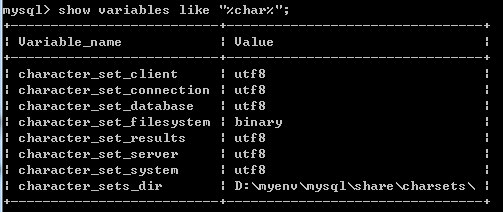开发过程遇到的中文乱码问题
对于程序猿来说,乱码问题真的很头疼,下面列举几种常见的乱码。
1.数据库编码不一致导致乱码
解决方法:
首先查看数据库编码,输入:
show variables like "%char%";

确认编码一致,如果不一致,可输入:
SET character_set_client='utf8';
SET character_set_connection='utf8';
SET character_set_results='utf8';
也可设置成gbk编码;
也可以在安装Mysql目录下修改my.ini文件
default-character-set=utf-8
2.jsp页面乱码问题
在myeclipse中jsp的默认编码为ISO-8859-8;
只需在页面头部修改为
<%@page pageEncoding="UTF-8" contentType="text/html; charset=UTF-8" %>
在JSP页面头部加入下面这句话,告诉浏览器应该调用UTF-8的字符集。
<meta http-equiv="Content-Type" content="text/html; charset=utf-8"/>
3.jsp连接数据库存入中文乱码
在数据库连接时
jdbc:mysql://localhost:3306/test?useUnicode=true&characterEncoding=utf-8
如果使用框架连接则把头文件都修改成UTF-8编码即可
4.在使用struts2可使用过滤器:
先变写一个过滤器
package com.oumyye.util; import java.io.IOException; import javax.servlet.Filter; import javax.servlet.FilterChain; import javax.servlet.FilterConfig; import javax.servlet.ServletException; import javax.servlet.ServletRequest; import javax.servlet.ServletResponse; public class CharacterEncodingFilter implements Filter{ protected String encoding = null; protected FilterConfig filterConfig = null; public void init(FilterConfig filterConfig) throws ServletException { this.filterConfig = filterConfig; this.encoding = filterConfig.getInitParameter("encoding"); } public void doFilter(ServletRequest request, ServletResponse response, FilterChain chain) throws IOException, ServletException { if (encoding != null) { request.setCharacterEncoding(encoding); response.setContentType("text/html; charset="+encoding); } chain.doFilter(request, response); } public void destroy() { this.encoding = null; this.filterConfig = null; } }
在web.xml中配置
<?xml version="1.0" encoding="UTF-8"?> <web-app xmlns:xsi="http://www.w3.org/2001/XMLSchema-instance" xmlns="http://java.sun.com/xml/ns/javaee" xmlns:web="http://java.sun.com/xml/ns/javaee/web-app_2_5.xsd" xsi:schemaLocation="http://java.sun.com/xml/ns/javaee http://java.sun.com/xml/ns/javaee/web-app_3_0.xsd" version="3.0"> <display-name>0001web</display-name> <!-- 中文编码过滤器 --> <filter> <filter-name>CharacterEncodingFilter</filter-name> <filter-class>com.oumyye.util.CharacterEncodingFilter</filter-class> <init-param> <param-name>encoding</param-name> <param-value>UTF-8</param-value> </init-param> </filter> <filter-mapping> <filter-name>CharacterEncodingFilter</filter-name> <url-pattern>/*</url-pattern> <dispatcher>REQUEST</dispatcher> <dispatcher>FORWARD</dispatcher> </filter-mapping>
在表单中只能使用post传值,此方法对于get无效。
5 处理单个字符串的中文乱码问题
String newname=new String(name.getBytes("iso-8859-1"),"utf-8"))
附:JSP中的编码设置
1. pageEncoding:<%@ page pageEncoding="UTF-8"%>
设置JSP编译成Servlet时使用的编码
2. contentType: <%@ page contentType="text/html; charset=UTF-8"%>
对服务器响应进行重新编码,即jsp的输出流在浏览器中显示的编码
3. html页面charset:<META http-equiv="Content-Type" content="text/html; charset=UTF-8">
网页的编码信息 ,说明页面制作所使用的编码
4. request.setCharacterEncoding() -- 可用在servlet和jsp页面中
作用是设置对客户端请求进行重新编码的编码,即post方式提交的数据进行编码。
5. response.setCharacterEncoding() -- 可用在servlet和jsp页面中
对服务器响应进行重新编码,即jsp的输出流在浏览器中显示的编码,与<%@ page contentType="text/html;charset=UTF-8"%>一样
6. response.setContentType() -- 可用在servlet和jsp页面中
对服务器响应进行重新编码,即jsp的输出流在浏览器中显示的编码,与<%@ page contentType="text/html;charset=UTF-8"%>一样
7.response.setHeader("Content-Type","text/html;charset=UTF-8"); -- 可用在servlet和jsp页面中
与<META http-equiv="Content-Type" content="text/html; charset=UTF-8">一样